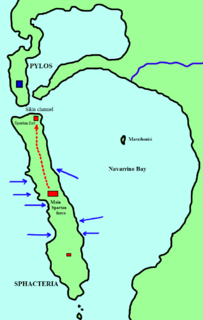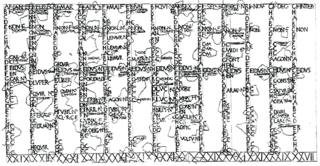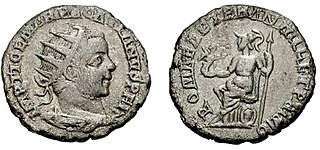
The Peloponnesian War was an ancient Greek war fought by the Delian League led by Athens against the Peloponnesian League led by Sparta. Historians have traditionally divided the war into three phases. In the first phase, the Archidamian War, Sparta launched repeated invasions of Attica, while Athens took advantage of its naval supremacy to raid the coast of the Peloponnese and attempt to suppress signs of unrest in its empire. This period of the war was concluded in 421 BC, with the signing of the Peace of Nicias. That treaty, however, was soon undermined by renewed fighting in the Peloponnese. In 415 BC, Athens dispatched a massive expeditionary force to attack Syracuse, Sicily; the attack failed disastrously, with the destruction of the entire force in 413 BC. This ushered in the final phase of the war, generally referred to either as the Decelean War, or the Ionian War. In this phase, Sparta, now receiving support from the Achaemenid Empire, supported rebellions in Athens's subject states in the Aegean Sea and Ionia, undermining Athens's empire, and, eventually, depriving the city of naval supremacy. The destruction of Athens's fleet in the Battle of Aegospotami effectively ended the war, and Athens surrendered in the following year. Corinth and Thebes demanded that Athens should be destroyed and all its citizens should be enslaved, but Sparta refused.

The 5th century BC started the first day of 500 BC and ended the last day of 401 BC.
This article concerns the period 429 BC – 420 BC.
This decade witnessed the continuing decline of the Achaemenid Empire, fierce warfare amongst the Greek city-states during the Peloponnesian War, the ongoing Warring States period in Zhou dynasty China, and the closing years of the Olmec civilization in modern-day Mexico.

Acarnania is a region of west-central Greece that lies along the Ionian Sea, west of Aetolia, with the Achelous River for a boundary, and north of the gulf of Calydon, which is the entrance to the Gulf of Corinth. Today it forms the western part of the regional unit of Aetolia-Acarnania. The capital and principal city in ancient times was Stratos. The north side of Acarnania of the Corinthian Gulf was considered part of the region of Epirus.
Year 413 BC was a year of the pre-Julian Roman calendar. At the time, it was known as the Year of the Consulship of Cossus and Medullinus. The denomination 413 BC for this year has been used since the early medieval period, when the Anno Domini calendar era became the prevalent method in Europe for naming years.

Year 414 BC was a year of the pre-Julian Roman calendar. At the time, it was known as the Year of the Tribunate of Cossus, Ambustus, Potitus and Albinus. The denomination 414 BC for this year has been used since the early medieval period, when the Anno Domini calendar era became the prevalent method in Europe for naming years.
Year 424 BC was a year of the pre-Julian Roman calendar. At the time, it was known as the Year of the Tribunate of Crassus, Fidenas, Rutilus and Iullus. The denomination 424 BC for this year has been used since the early medieval period, when the Anno Domini calendar era became the prevalent method in Europe for naming years.
Year 425 BC was a year of the pre-Julian Roman calendar. At the time, it was known as the Year of the Tribunate of Atratinus, Medullinus, Cincinnatus and Barbatus. The denomination 425 BC for this year has been used since the early medieval period, when the Anno Domini calendar era became the prevalent method in Europe for naming years.
The Peace of Nicias, also known as the Fifty-Year Peace, was a peace treaty signed between the Greek city-states of Athens and Sparta in March 421 BC, ending the first half of the Peloponnesian War.

Nicias, was an Athenian politician and general during the period of the Peloponnesian War. Nicias was a member of the Athenian aristocracy and had inherited a large fortune from his father, which was invested in the silver mines around Attica's Mt. Laurium. Following the death of Pericles in 429 BC, he became the principal rival of Cleon and the democrats in the struggle for the political leadership of the Athenian state. He was a moderate in his political views and opposed the aggressive imperialism of the democrats. His principal aim was to conclude a peace with Sparta as soon as it could be obtained on terms favourable to Athens.

The Sicilian Expedition was an Athenian military expedition to Sicily, which took place 415–413 BC during the Peloponnesian War between the Athenian empire on one side and Sparta, Syracuse and Corinth on the other. The expedition ended in a devastating defeat of the Athenian forces.
The Battle of Olpae was a battle of the Peloponnesian War in 426 BC, between armies led by Athens and Sparta.

The Battle of Sphacteria was a land battle of the Peloponnesian War, fought in 425 BC between Athens and Sparta. Following the Battle of Pylos and subsequent peace negotiations, which failed, a number of Spartans were stranded on the island of Sphacteria. An Athenian force under Cleon and Demosthenes attacked and forced them to surrender.
Laches was an Athenian aristocrat and general during the Peloponnesian War.
The Battle of Idomene was a battle in the Peloponnesian War in 426 BC, between the Athenians and the Ambracians.
The Aetolian campaign, often referred to as "Demosthenes' Aetolian campaign", was a failed Athenian offensive in northwestern Greece during the Archidamian War. In 426 BCE, Demosthenes was dispatched from Athens to the Corinthian Gulf in command of a fleet of 30 ships. Arriving in the northwest, he quickly assembled a coalition force from Athens' allies in the region and besieging the city of Leucas. Before that siege reached a conclusion, however, he was persuaded to abandon it in favor of an attack on the tribal region of Aetolia. Leaving Leucas, he set out towards Aetolia, losing along the way several major contingents from his army, whose leaders were apparently unhappy with his change in strategy.
Olpae or Olpai was a town of ancient Amphilochia, where the Battle of Olpae was fought between the Spartans and the Athenians in 426 BCE during the Peloponnesian War. Olpae sat upon a fortified hill, in the territory of Amphilochian Argos, 25 stadia from Argos itself. Eurylochus, the Spartan commander, marched from Aetolia, with 3000 hoplites into the territory of Amphilochian Argos, and captured Olpae. Thereupon the Acarnanians marched to the protection of Argos, and took up their position at Crenae. Meantime Eurylochus, with the Peloponnesian forces, had marched through Acarnania, and had succeeded in joining the Ambraciots at Olpae, passing unperceived between Argos itself and the Acarnanian force at Crenae. He then took post at Metropolis, probably northeast of Olpae. Shortly afterwards Demosthenes, who had been invited by the Acarnanians to take the command of their troops, arrived in the Ambraciot Gulf with 20 Athenian ships, and anchored near Olpae. Having disembarked his men, and taken the command, he encamped near Olpae. The two armies were separated only by a deep ravine: and as the ground was favourable for ambush, Demosthenes hid some men in a bushy dell, so that they might attack the rear of the enemy. The stratagem was successful, Demosthenes gained a decisive victory, and Eurylochus was slain in the battle. This victory was followed by another still more striking. The Ambraciots at Olpae had some days before sent to Ambracia, to beg for reinforcements; and a large Ambraciot force had entered the territory of Amphilochia about the time when the Battle of Olpae was fought. Demosthenes being informed of their march on the day after the battle, formed a plan to surprise them in a narrow pass above Olpae. Demosthenes sent forward a detachment to secure the peak above the pass, and then marched through the pass in the night. The Ambraciots had obtained no intelligence of the defeat of their comrades at Olpae, or of the approach of Demosthenes; they were surprised in their sleep, and put to the sword without any possibility of resistance.
Amphilochian Argos was the chief town of ancient Amphilochia, situated at the eastern extremity of the Ambraciot Gulf, on the river Inachus. Its territory was called Argeia (Ἀργεία).











